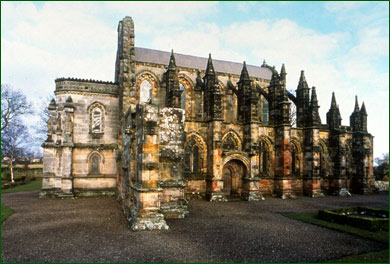
Rosslyn Chapel, situated some six miles south of Edinburgh, has for more than five centuries stood as a monument to truth and a beacon to virtue, an imposing and lasting tribute to the spirit of the Knight Templars of old and the operative Craftmasons of Scotland. Whether or not it is, as some claim it, a “Bible in Stone,” it is unquestionably an edifice of mystic and historic worth, more particularly for those who are interested in the pre-speculative origins of Freemasonry.
It is not to the outside, however, but to the inside, that both the casual observer and the student of Masonry’s origins invariably turn their attention. Baignet and Leigh find the interior of the Chapel, to be “a fevered hallucination in stone, a riotous explosion of carved images and geometrical configuration piled on top of one another, flowing into one another, overlapping one another.” To Wallace-Murphy, in contrast, the interior is distinguished primarily by the “variety, candour and exuberance of its carvings,” some of which are “more like works of nature than of man.” The Chapel and its appointments, according to this source, are largely attributable to an inspired plan, a gifted man (St. Clair), and construction that proceeded at a pace that precluded “contamination of the original conception from outside influences.”
What is it about these carvings that have so captivated the interest of observers over the ages? Knight and Lomas believe it is because they speak symbolically about cultural and moral values whose origins are Egyptian, Celtic, Jewish, Templar and Masonic in origin. According to them the Chapel’s distinctly Christian imagery, the stained glass windows, a statue of Madonna and child, and the baptistery, was added centuries after the original work in the Chapel had been completed.
Foremost among the original carvings are three pillars that stand on a stage at the east end of the Chapel. These pillars have been designated the “Apprentice’s Pillar,” the “Journeyman’s Pillar,” and the “Master Mason’s Pillar”. The most impressive of the three is the Apprentice’s Pillar, to which is attached a legend that involves the murder of the Craftsman who is presumed to have created.
According to this legend a model of the pillar is supposed to have been sent from someplace in Europe to be used as a pattern in the cutting of the pillar in stone. The master on viewing the model concluded that he must see the original from which the model was made, before starting his work. While away on his inspection tour, an apprentice rose to the challenge and carved the pillar as it now stands.
The Rosslyn Chapel web site has a downloadable leaflet, things to do and directions.







